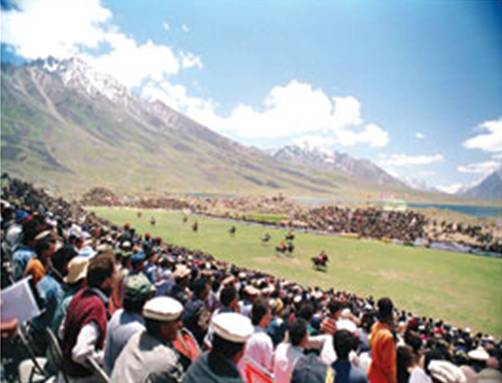Gilgit-Baltistan: Polo
This is a collection of articles archived for the excellence of their content. Readers will be able to edit existing articles and post new articles directly |
Gilgit-Baltistan: Polo
The king of games
By Manzoor Ali Shah
The game of polo has been played for a long time in the world, but in Pakistan it sometimes assumes mythical importance
Pakistan’s northern areas are famous for their natural beauty. They have awe-inspiring mountains, serene lakes, roaring rivers and gigantic glaciers. But the game of polo attracts many a visitor to the region for reasons other than watching nature’s munificence.
Polo is one of the oldest games played in the world. And the northern areas are known for the kind of polo played here. Every year, in the second week of July, polo teams from Chitral and Gilgit face each other in Shandur — the world’s highest polo ground. This event dates back to old colonial times when in the ‘30s a British political agent, Maj Evelyn Cobb, who was fond of playing the game in the moonlit Shandur, initiated polo matches in the area.
The Shandur pass is situated about 3,738 metres above sea level and lies between Gilgit and Chitral. It is 147kms away from Chitral and 211kms from Gilgit. In the winter, it remains frozen due to the heavy snowfall that engulfs everything beneath its white blanket. At the end of the spring season, this area — a plateau among the Hidukush Mountains — becomes a lush green land. And the greenery with galloping horses, the zealous spectators and the tent city in the high Hidukush underneath the open skies in the background of the Shandur Lake, present a magical view.
As Shandur has a mythical importance in Chitrali folklore, it is said that it is the abode of the fairies (Shhawanan), and at night these fairies come down to the lake and splash its water.
Nowadays, open air cultural festivities, including dance shows and concerts, are held here during nighttime as part of polo matches in which maestros from Gilgit and Chitral enthral the audiences with their performances. And during daytime, polo matches catch the public’s attention.
An international polo match is divided into six chukkers (circles), each is seven-and-a-half-minute long. And an umpire, riding a horse, monitors the game. Usually, one team consists of three or four players. The polo played in the northern areas is different in many respects from international polo. Here, the game is divided into two stints of 25 minutes each with a break of 10 minutes between them. Unlike international polo, one cannot change one’s horse — only if the horse receives serious injuries. Rules are few and there is no referee or umpire. The only official is a time-keeper. There are 12 players, six from each team. A player can hit his opponent with his mallet, give him a push, and run over his opponent’s horse. And the 12 players pursue the ball in such a frantic manner that it leaves spectators in awe. Generally, a swollen face, a bandaged head or a limping horse shows that the match was interesting enough.
Polo originated in Persia in 500BC. Polo is basically a Balti word, meaning ball. In Persian it is known as “Chowgan”. Initially, polo was played as part of the training of imperial cavalry guards. From Persia, polo spread into far-flung lands like China, Japan, Egypt, and Byzantine and became a royal pastime. Even in the subcontinent, it is said that Sultan Qatubudin Abik died after falling off a pony while he was playing polo. In China, the death of a court favourite during a polo match in 910 made the king order the beheading of all players. In the 13th century. polo was in vogue in Central Asia after being introduced there by Muslim conquerors. From Central Asia, perhaps, it made inroads into the northern areas of Pakistan.
Chitral, Gilgit, and the northern areas are the places where polo is played in its age-old style. How much the people of these region love this game can be judged from the fact that in the northern areas in the heart of each village and locality we find a polo ground. It is obviously a sacrifice keeping in view the scarcity of land. As in the case of Chitral, 70 per cent of the population lives below the poverty line and earns less than Rs5,000 a month. Their lavish spending on polo shows that these poor people consider this game something mythical.
When a polo match starts, local musicians play traditional tunes. When a goal is scored, the player who has scored it gallops towards the centre line holding the ball in his right hand, and on reaching the centre line tosses the ball into the air and hits it with his mallet while in the background musicians play a special tune for him. This is called Thompq in Chitral.
